In Praise of Digital vs Film (v4) + Reader Comments (updated late 2023-12-10 15:12)
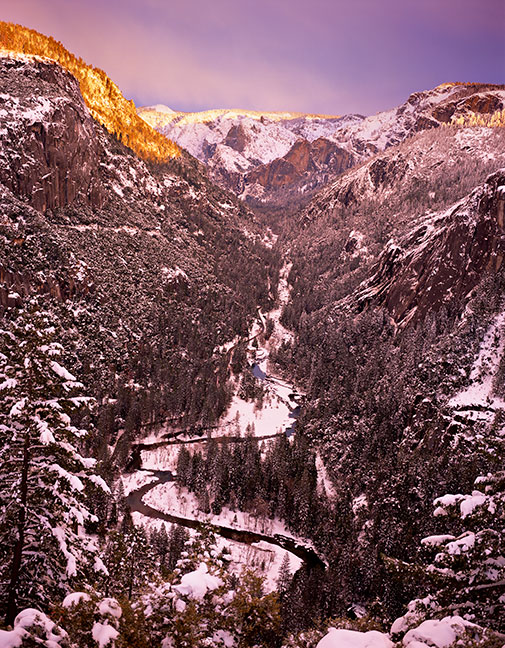
Mamiya 7 II, 150mm, f/11, Fujifilm Velvia 50
Film is seeing renewed interest.
This is a repost almost exactly two years later of the the 2021 post
...
My 2013 article Photographic Film Really Was Not Much of a Performer was not well-received by those with strong cognitive commitments to the contrary, but I stand by it (and see Rich S’ comments), because after shooting and scanning (including drum scanners) 4X5 and 6X17 and 6X7 and 35mm, it became more and more clear that alleged resolution numbers capture little about the differences, and are pretty much bullshit for real photos.
That’s not to say that top notch results were unobtainable, but you needed excellent lighting and a large format and perfect execution and not too much diffraction and pro-grade scanning. And even 6X7mm struggled to make a 30-inch print that could compete in sharpness with any of today’s ~45 megapixel cameras, or even 24MP.
BTW, I do have an Hasselblad + 80mm and an old Nikon something with winder for sale... plus a Schneider 400mm f/5.6 APO-TELE-XENAR Compact MRC Copal shutter ($2300).
UPDATE, Dec 10 2023: I went back and looked at a variety of my 4X5 and 6X17 and 35mm film scans. More than ever, I say that what 4X5 and 6X17 could capture falls far short of the Fujfiilm GFX100S, not even getting to the 50 megapixel level. Probably the requirement for f/22 or f/32 so much of the time is a big part of it, but I doubt that even f/16 can offer satisfactory sharpness.
Even in theory, 30 lp/mm resolved on film (and ignoring grain!) is only 5 in X 25.4 mm/in * 30 *2 = 7620 dots = right in the range of what I would call out for actual detail (and being kind). But the GFX100S offers 11648 pixels across! Sure there are its analog properties, but the fact is the detail is just not there and this is evident whether with a 10X loupe or a scan. It’s not close to a contest, in favor of the GFX100S. Finally, consider Topaz Gigapixel AI even from a 40-50 megapixel camera, and it’s no contest in favor of digital.
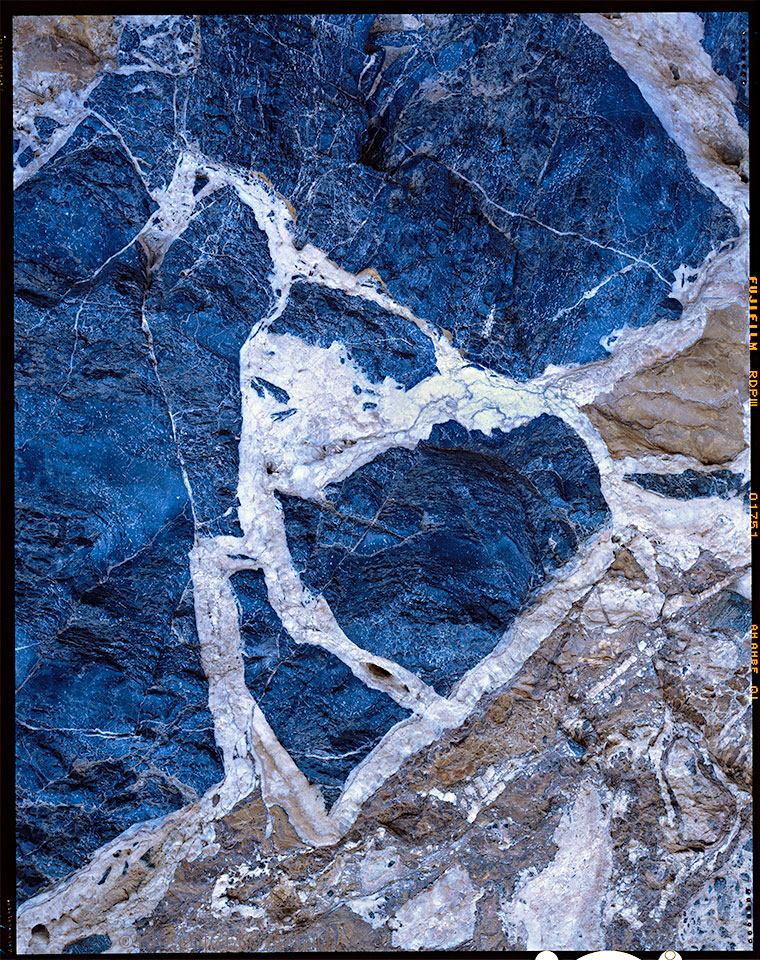
Linhof 4 X 5, 90mm lens, Fujichrome Provia, ~1999
Below, I was thinking about old summit climbs, and here I post a few scans from old Kodachromes. Not the best scans in this case, but the key characteristics of just how awful film was are plain to see (grain, very limited fine detail, poor dynamic range, color).
Even an iPhone could have made superior images here in many ways, though I’d want DNG for detail. I think these images were taken with a Nikon FE2 and Nikon 55mm f/2.8 Micro-Nikkor—at the time considered one of the very best lenses. Amazingly, you can still buy the Nikon 55mm f/2.8 Micro-Nikkor and it’s not cheap!
With color-reversal (slide) film in harsh shooting conditions like this, you got blown-out highlights or pinned-to-black shadows, or both. Even color negative film was hard-pressed, and unless you shot B&W film and were really careful in development... good luck. But with digital and proper exposure, I could have had excellent detail in both highlights and shadows and far superior resolution and color and barely-visible noise.
Most striking here is that these ~8-megapixel scans are visibly short on resolved detail, even while filling little more than half of my iMac 5K display.
Does that mean the images suck? Certainly not. They have their limits, but I am very glad to have made them.
Aside from hair on my head, it is astonishing was just how crappy my clothing/boots were back then. It is easy to forget how even clothing and footwear are so much better today. I still have the ice axe, though mostly it’s for digging a hole for a dump.

Nikon FE2 + Nikon 55mm f/2.8 Micro-Nikkor, Kodachrome 25

Nikon FE2 + Nikon 55mm f/2.8 Micro-Nikkor, Kodachrome 25
With the lighting right, the contrast issues were fine, as here. But detail... an iPhone could easily outperform this, albeit with ugly digital artifacts. Film probably better in this case than an iPhone for the subjective qualities.

Nikon FE2 + Nikon 55mm f/2.8 Micro-Nikkor, Kodachrome 25
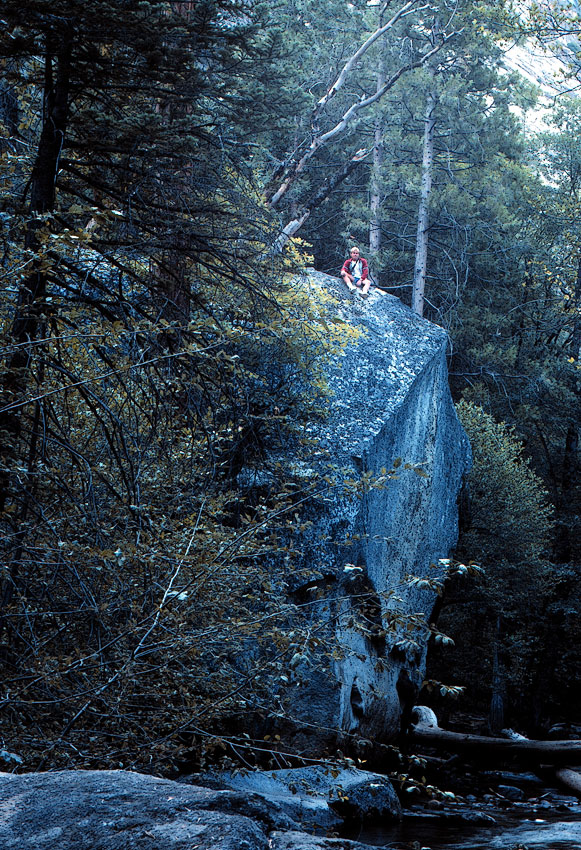
Minolta XD-7, Kodachrome 25, 1954 X 2859 scan
Claude F writes:
Kodachrome was able to work with two stops of dynamic range. Fuji ASTIA six. I used 4x5 Vericolor long exposure negative film which was good for eight stops but with the corresponding, and difficult color cross over problems. Back in the day there were other options that were close to impossible to deal with. Color duplicating film with its very flat but wildly varied color balance was a tried but never fully developed experiment.
Flat bed scanning has gotten better, but is nevertheless another step in an already complicated process
I well understand the advantages of using a 4x5 camera. I also well understand the limitations of always having to work on tripod.
There is a common misconception that using film in some way slows the process of making pictures more time consuming. I spend just as much time composing a digital composition as I did using film. Digital or film has nothing to do with creating a picture, for me at least. And I could set the view camera up, focus, meter and shoot two exposures in less than two minutes. Takes less time with digital once I’m at the camera but that’s not where I spend the time needed to make a photo.
[DIGLLOYD: agreed, same finding/hiking/setup/composing time, but I myself would emphasize the ''pain' of filming into a scan, which Claude and I agree on entirely after speaking about it on the phone]In my book if someone wants to use film or numbers to record a scene that’s simply a preference. I still carefully consider the contrast range of a subject and never rely on a sensor to handle over eight stops of dynamic range.
There is a certain cachet associated with the use of film, but what is not widely known is that once the film is scanned, it becomes a digital file subject to the same post process as a digital first file. A film to wet darkroom print has no where near the ability to be changed, but still masking, burning dodging, tone scale, can be manipulated by the artist to the point where the departure from “what was there” is striking.
The bottom line for me after using a view camera and film for 30 years was that digital could finally match what I did with the view camera. And it’s not until the capabilities of the Fujifilm GFX 100s that the capability is solid with a single exposure.
DIGLLOYD: Claude’s images total maybe 10 a year shot under selective conditions, and likely not shot under the conditions most unfavorable to film. Different premises from mine.
UPDATE 2: I spoke with Claude at length (phone); we really aren’t saying anything different. And of course subject matter and its lighting can have a significant influence on the capture vs the medium. Claude’s note was never meant to be an essay to fully treat the matter (and while I asked before publishing it, it is also true that I knew it might not adequately cover his viewpoint).
The “preference” of film carries with it a heavy time and cost burden, along with very limited and expensive film choices, even ignoring developing and scanning [update: Claude had just not made that as explicit, and we are in agreement that film carries a burden with it]. And even the best scan cannot recover blown highlights or pinned shadows in 'post'. I could see shooting B&W film for its control during development, but not much else.
The bottom line for me is that in examining my best 4X5 and 6X17 and 35mm film images (10X loupe or scanned), the detail and dynamic range invariably quickly show limits. Fifteen years of digital only reinforce that impression and at 45-50 megapixels.
But the bottom line is this: show me the evidence. I have a number of Christopher Burkett prints, some up to 40X30 and shot on 8X10 film. . I’ll concede that if you shoot a 4X larger film area than 4X5 (8X 10 film), and are one of the world’s best printers taking weeks or months to get a print right, and expose in for ideal lighting with 30 years of experience nailing it... yeah you can do darn well
Film below was scanned at 15972 X 5366 (image area from 17732 X 6066). Probably shot at f/22, Fujichrome Velvia 50. Sharpness is consistent with many other 4X5 and 6X17 images. Size 11648 is the width of the Fujifilm GFX100 II sensor. Whatever appealing non-digital qualities it has (yes it does), the sharpness is abysmal compared to digital.
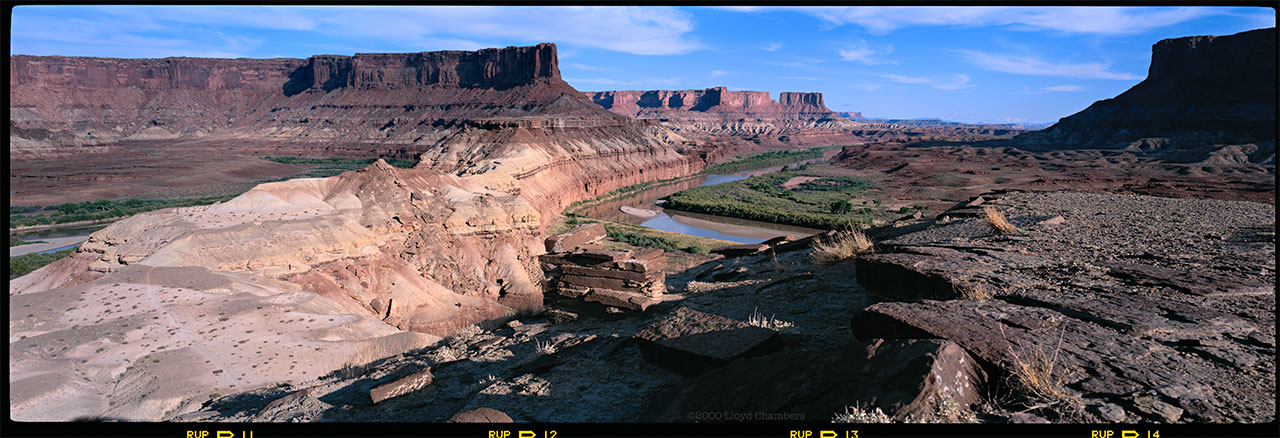
Linhof 6 X 17 S III, 90mm lens, Fujichrome Velvia 50
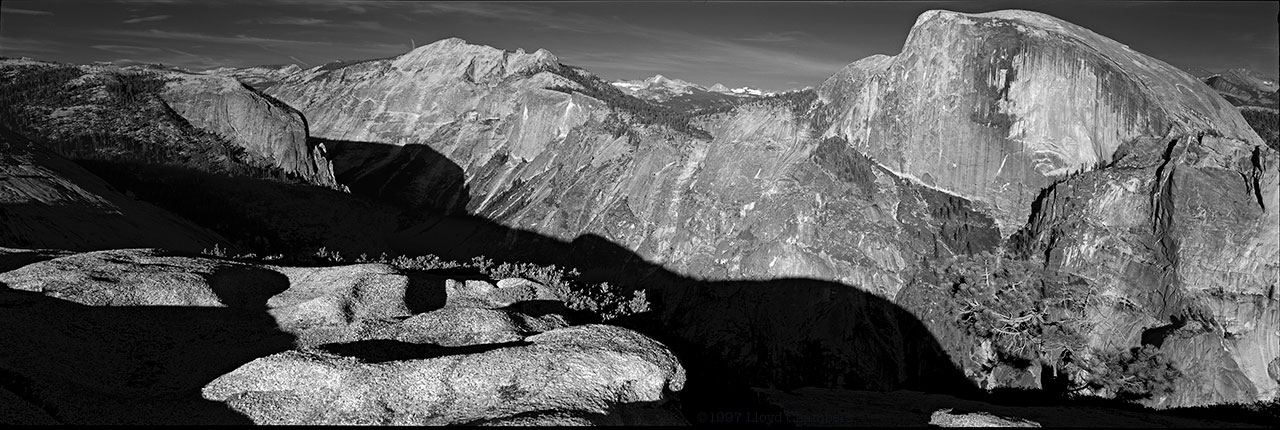
Linhof 6 X 17 S III, 90mm lens, Fujichrome Velvia 50
Example: Mamiya 7 II 6X7 film scan
Those who remember the Mamiya 7 II and its lenses know that you’d be hard pressed to find sharper optics. While a 4X5 would capture about 3.3X more area (~100 X ~127mm vs 56 X 70mm), the linear resolution increase would be about 1.8X, and it’s doubtful that the lens can deliver as much per-area sharpness over the entire 4X5 film (even assuming film flatness is perfect) as can the Mamiya lenses on 6X7 film. The gains would lessen but not close the gap.
Below (see crops), detail as scanned from oil-mounted chrome on the Tango drum scanner shows nothing remotely approaching what I would call sharp by comparison with today’s digital cameras.
Tango drum scanner: 7242 X 9294 = 67 megapixels. Actual film area of 6X7 is about 56 X 70mm.
The reduced size 3620 X 4646 = 16.8 megapixel image shown below is a size I deem disappointingly soft and yet it is a 2X linear reduction from the full-res scan! Downsampling 2X linearly for a 4X pixel reduction yields an image notably less sharp than what I would expect from even a 24 megapixel digital camera.
An image at f/8 or f/11 would have slightly better sharpness and maybe not, as depth of field might be too low for any field curvature. Plus DoF on 6X7 mandates f/16 most of the time (equivalent to f/8 on 35mm format). I’ll also grant that a lens superior to the already outstanding Mamiya optics could do a smidgen better. Both of which change nothing.
This example is a very fair example of how well you can do with film—it represents not just typical but very good results—it is in-focus at uniform distance and at the ideal aperture for the format and scene (f/11). The Mamiya lenses on 6X7 were highly respected for sharpness and do as well here as anything on 35mm. In other words, I see the same or better resolving power on a much larger piece of film than 35mm.

Mamiya 7 II, 150mm, f/11, Fujifilm Velvia 50
Below, two actual pixels crops from the full-res 67-megapixel scan. You could get aggressive on sharpening, but it’s awfully damn soft. I would rate the detail as comparable to a 16 megapixel digital camera and with far more grain.
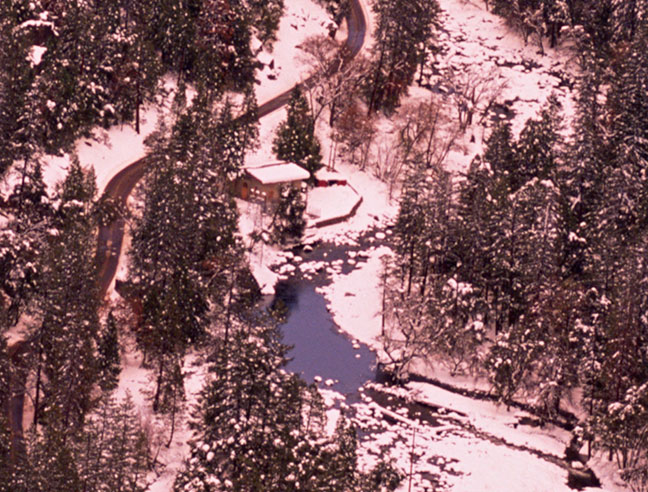
The grain in the sky is prominent, far inferior to what a 24-megapixel digital camera could deliver.
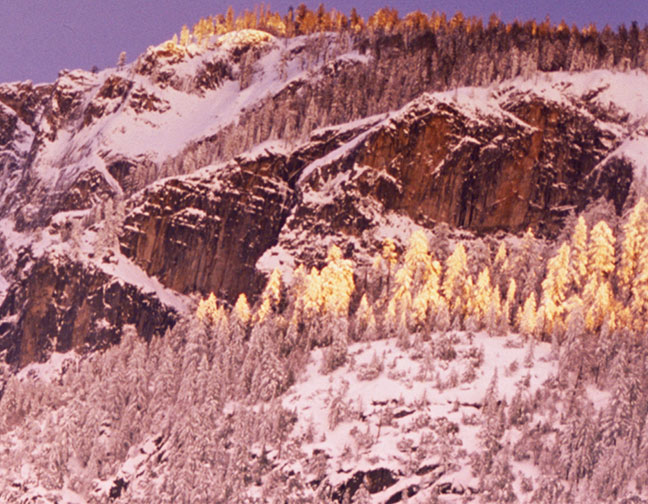
Bernd R writes:
As always an excellent analysis of this topic in your blog!
I fully agree that from an image quality point of view 6x7 is inferior to a current 45 megapixel camera when printed to 30 inch. It may however be good enough when viewed from a reasonable distance in my experience. For me, the main advantages of analog is in the process: I spend less time in front of a computer as compared to digital (thinking about mounting slides and projecting them), and the slide is authentic in the sense that the piece of film accompanied me on my adventure, and that the color rendering cannot be manipulated after the shot. Yet another advantage is that I get to use beautiful equipment (Mamiya RZ 67, Linhof Technica), which can be bought for 10 cent on the dollar used.
[Agreed on the beauty of a chrome, but slides end up in a box and de facto never get seen, over time, nor are they accessible to anyone not physically there]From a purely technical point of view, I believe it is not a fair comparison to post completely unedited scans in order to prove how bad they are - you would not post unsharpened and unedited raw files either. I took the liberty to edit two of your example files in my standard capturing work flow for scans, see attached (1-2 minutes each). They clearly are not pixel level sharp such as good digital files, but I believe they would print decently when choosing an appropriate print size.
DIGLLOYD: thoughtful notes like this and Claude’s are always appreciated.
I agree that pleasing prints from 6X7 and especially 4X5 can be made and indeed I made a goodly number from 35mm and some from 4X5 which still hang on my wall (the 4X5 ones). Which is of course different from saying they are nicely sharp.
When I review my prints from 35mm film (optical enlarger) at only 13X19 versus what I've printed off digital, they’re pretty awful in terms of sharpness and excessive grain, even the best of them. I also have several 4X5 foot prints from 4X5 chromes and they look great at moderate viewing distance and are obviously far superior to the 35mm results. But they’re still short on sharpness—I have one such print on my office wall and it looks great 6-8 feet away, but at 4 feet I start wishing I had more, because such details intrigue me vs the feel of being there—but those details and textures are lost forever.
I've also made 13X19 prints of 3 megapixels like the Nikon D2H—for portraits they are very satisfactory and better than the 35mm film images in every important way, and they look just as sharp as 35mm-film images. Not that sharp, but the brain doesn’t need a whole lot to see a face as sharp, and the sharpness was top-notch for the sensor resolution. So the specific subject matter is a real consideration too.
To establish a reference: my Sigma DP1 Merrill (14MP X true color pixels) made great-looking 4X5-foot prints than my 4X5 film images! My tulips image still hangs in the entry of my house and it competes if not beats 4X5 film very favorably.
The 6X7 above had already gotten some Smart Sharpen and Unsharp Mask, enough to properly account for the scanning process, but not the amount I’d add for printing. The sharpening Bernd R added in his reply does add some acutance and of course will look better to the eye, and I concur that I'd do that (and more) for a print. But neither hair of legs nor twigs of trees are actually there—more like a enhanced edge contrast that at best is suggestive of detail—at least 2X if not 2.5X linearly less resolved detail than I’d like to see. The small trees are particularly revealing of having no real definition—we’re not seeing the branches defined.
I liken such sharpening to iPhone JPEG/HEIC images. By strongly accentuating the acutance (de facto MTF eg contrast) of coarse and medium structures, the eye sees "sharp" at first glance. Because the eye responds first to edges of any size, and sharpness comes later and only with examination. But when I look at such iPhone images, all the fine detail is smeared away—no hair, no weave of cloth, no pine needles, no textures, blotchy skin, etc. That is why I shoot DNG with the iPhone when it matters—the difference is huge and if you’re not seeing it, you’re looking at it wrong, perhaps at reduced size and/or at Retina resolution which exceeds the human eye’s resolving power for most of us.
Rich Seiling writes:
Reading the film vs digital post with great interest. I did some testing during the WCI days that might be of interest to your readers. I’ve attached a couple quick screenshots to give you an idea. Pre digital I photographed the same scene in Yosemite with 35mm, Pentax 6x7, Hasselblad, and 4x5 with a Nikkor lens with lenses of similar view angle, roughly a 35mm focal length in 35mm format. I continued to photograph this scene with digital as time when on. Film was scanned on my Tango and some were scanned at “oversampled” resolutions. I’m willing to share more files if it is of sufficient interest. If I had to do this over, I would control more variables in regards to optimum apertures as we understand it now, so while it is a very good snapshot, it is not the absolute end all answer, if there even is such a thing.
I have given the resolution comparison of film formats and digital much thought and study, and have a draft of an article comparing film to digital resolution that remains unfinished because it is not a topic many people care about currently, but I needed to resolve some of these issues for myself.
Haven seen and made scans and prints for some of the most highly regarded photographers in the world, I have a pretty good idea what “good” film looks like and what it can do in a print. I’ve seen a lot of “average" film, as well as superb film. Few people made superb film as it requires the right equipment and intentionality, just as great results with digital does today.
As a rough ballpark that I am sure people will argue with, I believe that 4x5 film is roughly equivalent to 100-150mp based on making and comparing large prints (24x36? 30x40 for sure), not screen viewing. Film does look softer than digital on screen, but when you start making 3500spi scans of 4x5 made with good lenses, there is a lot that can be pulled out that makes very beautiful large prints.
If we accept that 100-150 mp value 40r 4x5 film, we can achieve that number of pixels with a 2300 to 2750 spi (spots per inch) scan. Using the same spi, we get the following values for other films:
8x10 423-600mp
6x7 32-46mp
6x6 26-38mp
645 21-30mp
35mm 7-10 mp
Disk film … just joking but probably 640x480There is going to be a lot of variability in the resolution of film due to lens quality, diffraction from using too small an aperture, and sloppy technique. How much data the film can hold and how much is actually transmitted to it by the lens is a much bigger delta than people want to believe.
Continues...
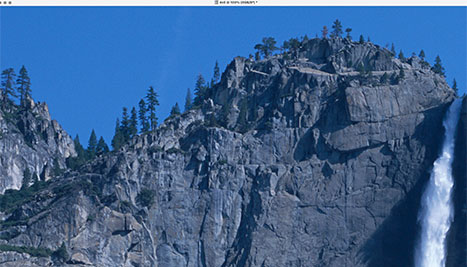 Example from Rich Seilig: 4X5 scan
Example from Rich Seilig: 4X5 scan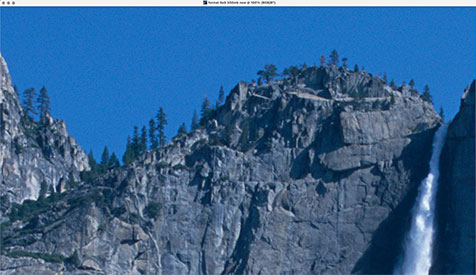 Example from Rich Seilig: 6X6 scan
Example from Rich Seilig: 6X6 scan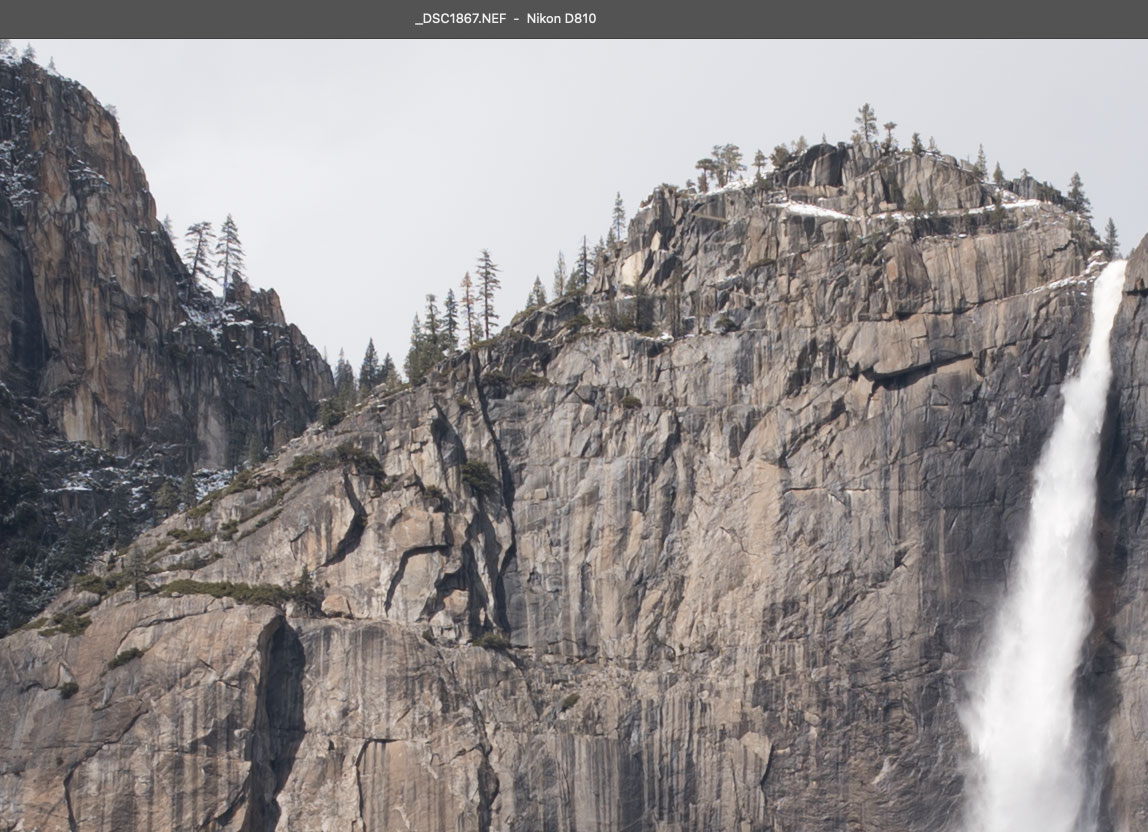 Example from Rich Seilig: Nikon D810
Example from Rich Seilig: Nikon D810As a check on these numbers, feel like the medium format numbers would be on the lower side because most medium format glass wasn’t that good. In my own test a early 1990s vintage Pentax 6x7 lens performed the same as a 1960s Zeiss lens on Hasselblad cropped to 645! Looking at countless scans over the years has reinforced that. Apart from Zeiss, the other brands were pretty average, even those held in high esteem at the time (no love for the Mamiya here.) I have a “favorite” image made on 6x7 that no way is as good as what I can do with my Sony A7RII and high end glass, so I think even 32MP is pushing it for that particular lens with 6x7 film. it’s 24mp?
I’ve also observed that prints from digital files look sharper when they provide 300ppi un-interpolated files at output size, but large format film gains an edge on larger size prints. A large scan of 4x5 can produce a 30x40 file at 300ppi with no problems and it does show some advantages there and at larger sizes. I have no hard numbers here as it is observational of a large number of prints rather than a side by side test. If making the best 30x40s was your thing, you’d want to look at 4x5 or 100MP and larger cameras, and 8x10 as well.
My personal feeling is that I would rather use a 24mp with great glass today than any MF film camera, and with 36mp cameras and above, there is no comparison. Digital solves a lot of problems the film process has which makes it easier to get better results from digital unless one is a experienced and dedicated user of large format. Furthermore, large format is plagued by focusing errors as well as imprecise use of its movements such that for 90%+ of users, they would get sharper photos from digital.
Large format film used properly is still amazing, and I’ve seen nothing in practical use that compares to 8x10 in terms of resolution. In the right light, film captures things in color I don’t see digital doing. Particularly golden hour and red sunset colors. I believe part of this is due to the color losses of the Bayer matrix and the RGB filters used, but also the IR cutoff filters cut off red light that is visible to the eye, and I have evidence that light can be recorded with cameras modified for astrophotography but goes orangish red on standard cameras. At it’s best, in the best conditions of rare, magical, fleeting light, film can record color and light in a way digital simply can’t. But that window is very small and hard to find, so for all the other times outside, digital expands the opportunities for making photographs and allows things film can’t do.
It really comes down to use what inspires you to keep photographing. They don’t have to be the same to justify the use of one or the other. I’m an advocate for making more pictures with whatever floats your boat. But if you are looking to achieve certain things, you do need to know their capabilities, and do your own testing.
DIGLLOYD: great info from someone with tons of experience!
I agree on the subjectivity involved, especially given the perceptual issues. For myself, I would downrate Rich’s numbers by 1/3 or so, given film behavior and grain, lens performance, film thickness, film flatnesss (particularly on 8X10 and 4X5 but also 6X17 and 6X7 formats), diffraction, depth of field (a big one!), focus errors, etc.
Lloyd’s equivalence subjective numbers:
8x10: 240 to 320 MP
4X5: 60 to 100 MP
6x7: 18 to 24 MP
645: 16 to 22 MP
35mm: 5 to 10 MP
Modern lens performance could make a 1/3 difference in the numbers, so I think numbers are defensible, though I will not insist they are “right”. Film-related drags on sharpness are high. The high number would be perfect execution at ideal aperture, the lower figure would be typical, including the requirement for stopping well down, which by f/22 is already hurting resolution very obviously (a 10X or 20X loupe proves that out).
Accepting Rich’s examples as expert-grade, I note that his 4X5 example looks pretty much like my 4X5 findings. When I upscale that Nikon D810 image to the same size as the 4X5, I can see that the 4X5 has a wee bit more detail. But it’s not persuasive, and the D810 is a 36-megapixel camera. A Sony A1 with top glass (or similar) would be awfully close, and maybe better, depending on subject matter? That argues for a 4X5 equivalence of around 50MP, which dovetails with my original claim about what the Sony A1 delivers. And what if Gigapixel AI were used on the digital image, with its ultra-low noise? I’d bet on the D810 in that case. Or what about a Panasonic S1R in multi-shot high-res mode?
And it’s not like you can easily focus stack with film—game over in massive favor of digital whenever DoF get involved—the elephant in the room by far.
Shown below, I took a fresh look at one of my sharpest 40 X 50 inch prints from 4X5, shot using the Rodenstock 135mm f/5.6 APO-Sironar-S on Fufjilm Velvia 50. I think it was at f/22, but I'm not certain. It is acceptably sharp at a viewing distance of two feet (too close for normal viewing)—not crisp but pretty good. Scanned on an Imacon Flextight at ~1880 ppi at 9429 X 7507 = 70.7 megapixels. A better scan could be done, but the scan at this resolution already suggests that most of the real detail has been captured. Still, perhaps a bit more could be extracted such that a large print would benefit in nuanced ways. And maybe that could slightly modify my figures above.
The image is pleasing and it hangs on my office wall, but it lacks the crispness that I am certain I could get with the Fujifilm GFX100, so what does that tell us?
I would therefore argue for a subjective perceived sharpness value of 60 to 80 megapixels for 4X5 as a typical achievable value, but often as low as 50 megapixels. That scan is 70 megapixels and falls right into that range, and I would not call it very sharp, were it a digitally-shot image. Would oversampling the chrome at 100 or 140 or 200 megapixels reveal meaningful detail such that it could be claimed to be 100 megapixels? Perhaps, but I am doubtful because I don’t think the scanning ppi is a significant gating factor here.
Rich Seiling writes in response:
And I think your evaluations are within the ballpark too. I’m erroring on the higher end, but I think that in most cases the lower value is more accurate for must camera/lens situations. And oversampling when scanning makes a difference too. Scanning a 4x5 at 2500spi vs 3500spi leads to about a 25% increase in apparent sharpness as the higher spi scan resolves the grain more clearly, which I have confirmed with multiple tests.
I have another scene shot with 4x5 and a 90mm Voigtlander on the D810 that I have printed to 30x40 and had very experienced viewers (my staff at WCI and a few photo friends) try to pick which was 4x5. The 4x5 users picked the 4x5 print and the smaller format users picked the D810 print. The D810 print had sharper edges, which is a strength of digital but the not edge detail was not as sharp. The 4x5 edges were a little more diffuse but it hat the appearance of more detail in non edge areas. Part of this was real I thin, but part is also induced by the grain of the film as I have observed many times that grain can create the appearance of sharpness. Neither were shot at the optimum aperture and suffer from more diffraction than I would consider acceptable now. But for most users, even 36mp cropped to 4x5 was giving 4x5 a good run. The differences at 50mp+ would become even smaller, particularly with very careful sharpening.
DIGLLOYD: sharper grain isn't necessarily more than a marginally sharper image, but I agree it could help some, particularly in the feel of the image and suggestive sharpness. Grain can make things look sharper to the eye... would be an interesting 3rd test if "Add Noise" was done to the digital variant—probably would look sharper!
Bottom line that everyone is agreeing on is that digital is awfully impressive, even if all you can use is "only" 35mm format. Excepting 8X10 film perfectly executed, I would say that current and future medium format cameras have let film far behind.
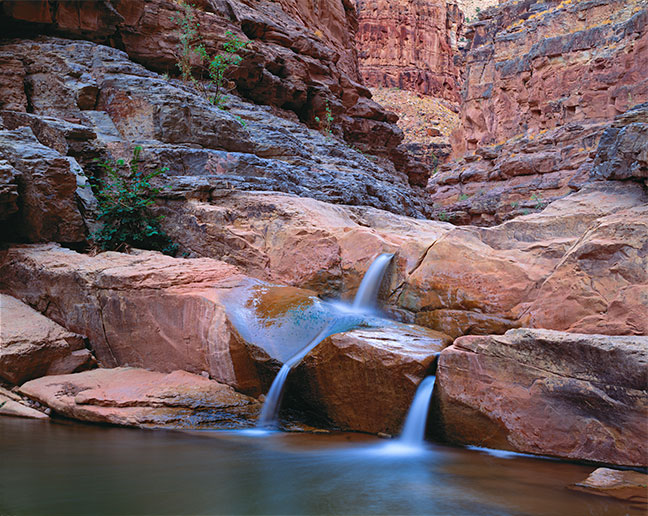
Depth of field is a factor in this shot. Good dose of Unsharp Mask wide radius contrast enhancement along with .
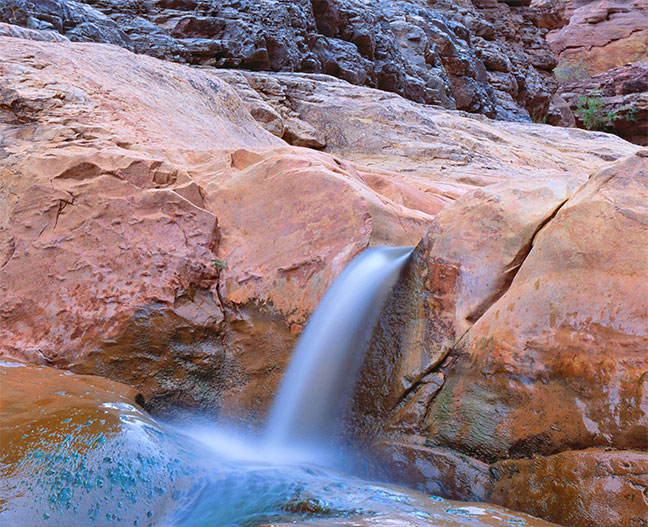
More reader comments (2023)
My comments are in no way a claim that my POV is the “right” one, any more than I’m going to argue that chocolate ice cream is better than strawberry. I see the whole thing as entirely subjective, a personal preference. I offer a counterpoint based on my experience and what I enjoy.
Jason W writes 2023-12-10:
As far as resolution goes, once you get to 60 megapixels the game is pretty much masturbatory. At normal viewing distances from non-photographer viewers, it's enough res in virtually all cases short of a 70 inch print, which let's face it, most people are not making.
The best technical argument for film I think is in handling highly saturated colors like reds, purples, and blues. Most CMOS just blow them out or just have poor tonality that's a PITA to Photoshop. Fuji's Color Chrome Effect will remedy this a little but then you're out of RAW-land and that's no good. Highly saturated colors on film dazzle while they look like a mistake on digital.
[diglloyd: what if the image, as most, have no such colors? Is the argument then moot?]And there are no good sims [simulations] of any slide films. Not really. Every last one looks like shit. That includes Fuji's built-in sims, which are interesting, but they don't look like the original films, nor are they intended to. They are notional and Fuji has stated as much. All said, I still like my best 6x17 Velvia slides better than pretty much any of my digital shots. When large format chromes hit they fucking hit. It doesn't take months of printing to get them right like you say. I drum scanned, edited, and printed once for all of them, and I can tell you, they came out great. I only got requests for prints when I shot film and those people still tell me how they prize those prints. I've shot for years on digital and I've won a couple Epson awards for digital shots, sold a couple digital shots (with difficulty), but nobody asks me for prints anymore. To be fair, I think most of the digital landscape shots I see are lifeless junk. But I sold my 6x17 camera to a kid in Austria and I loved his shots of Salzburg, even though they weren't perfect. He made them into a calendar and apparently sold them. Film like digital is its own thing, and if it works for what you want to do, it does.
Going digital was part of the technology upgrade-it is game I play though, and it's about avoiding the thing, and if I had to go back, I'd probably just tell me 10 years ago to just stick with film. I was always scared the chem would disappear and it sure has gotten crazy expensive, but it pales next to what I've blown on digital camera upgrades, which is second on paper only to my stock market and crypto losses in terms of bad financial decisions.
DIGLLOYD: Having shot 4X5 and 6X17 and having large prints from 4X5 on my wall and having owned a $10K Imacon scanner, Tango scans, etc, I have a qualified perspective. All the chromes sit in archival envelopes and are good for... nothing. Will I ever look at them again? Maybe not. Which means that what counts are the scans and only the scans or downstream product thereof... which show serious limitations in detail whether examined as scans or 20X loupe on the chrome.
Megapixels is about more than resolution; here in 2023 it's mainly about reducing digital artifacts (eg 200MP Fujfilm GFX200 would be better than 100MP just for artifact issues). Moreover, digital has not finished evolving and still sucks in some was as per my post just two days ago troubling problem for certain situations. In freedom from (some types of ) artifacts, film is way better. But not its contrast issues or grain, etc; an objective look at film's limitations would not be a small matter. If film had come after digital, would we see film’s issues in a different light? Grain in film is touted as a feature not a bug but IMO this is horseshit when it dominates details, as it does even on 4X5 all too often. Often ignored in “resolving power” discussions is the very strong overlay of grain relative to detail. If that’s your thing, fine, but it strays from objectivity as an obvious subjective viewpoint.
Most of all, I enjoy the details in my landscapes on my display as a direct link to where I’ve been. I don’t claim that others do or ought to, but that’s a big deal for me for certain types of images. To say that such intimate detail does not count assumes a false premise of purpose/intent. My display will be 16K in 10 years. If I had 10X the detail, that would be very nice. I like seeing where I’ve been, being able to zoom in and check things out.
And as my eyes age, this 'print thing' is total bullshit—viewing distance has to move out (presbyopia), or I have to put on special glasses... just doesn’t work (not enjoyable at all!)... any print smaller than 20 X 30 carries no interest for me, becuase it’s a PITA to view as I’d like. And that will only get worse as I age. See how subjective it is?
Corollary is that “artistic” landscape shots bore the shit out of me, the kind that everyone praises as ‘art’—so well composed blah blah. Fucking boring in most all cases. Not my thing. If it’s yours, all good, but it’s not mine. Collectors, after all, almost invariably collect what other people tell them is good. I reject the premise of collective truth.
Ask yourself this: if AI could create landscape images as good or better than the masters, would anyone want them? Hell no. It’s all about the psychology of humanity. Might as well prove that chocolate ice cream is best.
Prints… no room on my walls and I probably will never again make one... no relevance at all. Hence it supports no argument whatsoever from my POV.
Film could capture some colors that digital cannot. And digital can capture colors that film could not (particularly the PhaseOne Achromatic), especially darker tones that film just pinned to crap and full of chunks of grain. That argument IMO is fraught with missing context/perspective. And in the end (barring contact prints), film is only an intermediary, making the point moot unless the final display (your choice) can present it. I might never again look at my 'chromes' on a light box, so what good is the chrome?
Do I like my old 'chromes' better than what I can get today? In certain analog respects, yes. Overall... I would have happily had a Fujifilm GFX100S 20 years ago, instead of 4X5. I’ve had made far superior images both technically and artistically. In spite of the flaws of digital.
I have a few prints from 4X5 on my wall. They are nice enough I guess but even the best/sharpest are not all that sharp. I think my Sigma DP Merrill 14 megapixel print looks better than any of my film: a 6 X 4 foot print looks better than 4X5 IMO. Take that, film fans!
[in reference to my “corollary” comment above] Jason W writes:
I don't think people buy a lot of landscape photos to begin with. The style I shoot, what you'd probably call "Instagram" style, which is just the modern equivalent of classical romanticism focused on subjectivity and landscape as "sublime," isn't much regarded as art that blows people away anymore. My understanding of the history is this look started with Galen Rowell in the 80's with his graduated NDs and Kodachrome. Later we started to see a lot more of it with Velvia in the 90's, culminating with Peter Lik whose personality and marketing instructed people the couch photo of a sunset was a scarcity and valuable investment. (off topic side note: I lived on Maui and the Lahaina Gallery that launched Peter in the US burned down in the fire.)
A comment you made that people imbue shots they think were shot on film with a superior quality even if they turn out to be shot on digital I think is very true. I think it's because people believe film requires more time and is more challenging. It has never been measured but I think there's a psychological effect that we regard time as part of value, either as in long exposure time, or extra time and effort spent to create the image, or that the image is made of a collage of many exposures taken over a long time period. Additionally, I think that film is a physical object, there is an objet d'art inherent that which digital doesn't have.
Back when people trusted photos I've read some unfamiliar with the Sierras went to see them based on Rowell's pictures and were disappointed to learn it was all slide film contrast, polarizers and grads. That pissed people off back then but now nobody trusts photography, so it doesn't much matter what anyone does in this regard. This is the real loss. You call this the golden age of photography but I don't think so. I think that was the twentieth century to the end of the film era. The digital era from 2000 to 2015 was the Gilded Age where cellphones and digital took over, and now we're in the broken post modern cyberpunk Bladerunner era where quality and "talent" is mass produced and you can't tell real from fake and it's all roughly the same.
DIGLLOYD: some of my words might be interpreted as criticisms, but they’re really not. The comments on landscape are a personal commentary eg an image that conveys more intimacy with the landscape is far more appealing to me than the classic knock-your-eyeballs sort. It stems from a lifetime of close observation of the land at close range.
Much of what is considered art has to do with (a) the person, and (b) the time period in which they operated. Well, ALL of it. That’s the entire art world in a nutshell.
Not sure a 4X5 or 35mm qualifies as on objet d'art, but I’m all onboard with that idea when it comes to a glass plate or palladium print or some such. For which I have no desire myself but I get the appeal. Nor do I collect old corvettes. Were I to shoot film again, I’d shoot 8X10 or larger, ideally directly to plate so as to make such an object, and ideally a direct positive.
Peter M writes 2023-12-10:
Interesting review and comments on film v digital.
I’m totally digital now and would not revert to any film shooting. I feel that an interesting point is missing from the discussion, namely some of the old 35mm glass from the film days is actually fabulous.
The micro Nikkor 55mm f/2.8 AIS lens on a Nikon 45MP camera produces stunning images from f/5.6 through to f/16. This can be fixed to the camera with an FTZ adapter, or better, on a Kipon Tilt Adapter affording up to 10 degrees of tilt in any direction making it into an awesome solution. I carry 24, 28, 55 f/2.8 nikkors for use on the Kipon adapter, they are all magnificent. The 40mm f/2 Voigtlander on this adapter is also excellent.
I also have the fabulous Voigtlander Z 50mm f/2 APO 50mm f/2, which is only a little bit sharper than the Nikkor 55, and which delivers astounding bokeh at f/2 and f/2.8 due to near perfectly circular aperture.
DIGLLOYD: I have 30 or so older Nikkors. The older 35mm 'glass' was mostly far inferior to today’s designs. Some is good for sure (55/2.8 probably holds up in most respects), but I’d not be bet on older Nikkors much against newer lenses like Zeiss Otus or Voigtlander APO lenses, or even on aspects like lens coatings vs flare, or color aberrations or coma, etc.
What really matters is what a lens can do at the latest by f/5.6, since f/8 is already going south and any good lens is already declining by f/6.3, from diffraction. Even on a 45MP sensor, this is a factor.
Diffraction hits all lenses hard by f/11, and f/16 is a disaster. Film was not demanding enough for f/11 to be an issue and f/16 was fine on film (f/22 and f/32 showing losses), but high-res digital is another matter.
Rich S (professional printer for many years of many things) writes:
I wanted to add some updated information.
For me the question of “how many megapixels does film achieve” is really “how many megapixels do I need to match the results of 4x5 film on a 30x40 inch or 40x50 inch print.” Topaz upscaling had been a game changer for this. With a 40-50MP file run through Topaz, it is possible to achieve a large print that equals or exceeds that produced from a top quality drum scan of typical 4x5 film.
I explored the possibilities of Topaz extensively last year while printing large prints for Rhett Turner’s exhibit Conserving America’s Wildlands: The Vision of Ted Turner. I used Topaz on almost every image, as most were 24x36 or larger, with about half at 30x40 to 40x50, mostly from Nikon D850 files. I am still astounded by the results, and consider it the finest exhibition I have printed to date. The prints exceed what I would expect from 4x5 film, and many of the photos could not have been made with a 4x5, particularly the wildlife photos using long glass. This quality comparison is true even for photos taken at higher ISO levels, and zoom lenses, within limits of course.
The results I see using Topaz seals the deal for me. I can make better large prints with a 40MP camera than I can from 4x5 film. When the process is combined with great prime lenses and base ISO files, the results are even more breathtaking, and unlike anything I have seen before. When coupled with RAW capture and the processing/editing possibilities, digital unlocks so many more possibilities. This is not a knock on film, or the film look, just acknowledgement that using film requires tremendously more cost and effort for little advantage outside the film look unless you plan on making silver prints in a darkroom.
The unanswered question is “how many megapixels to match 8x10 film,” and if someone wants to pay for testing, I’ll answer it, but I’ve never been able to afford to photograph with 8x10, and now color 8x10 photography is astronomically expensive, so it is really not important for me to know it.
What I do know is that I am walking around with the best camera I have ever owned, and if I use it well, it will make files capable of prints beyond my dreams even though I used to use 4x5 film and owned a Heidelberg Tango drum scanner. Now all that is left is to go make more great photos and tell more stories.
DIGLLOYD: what Rich is referring to is the “lowly” Nikon D850 or similar. The D850 IMO with no PDAF pxiels to crapify the image remains one of the finest cameras ever made (I still have mine). See also Nikon D850 monochrome. I agree wholeheartedly on the “best camera” thing, particularly when we consider the Fujifilm GFX100 II or the PhaseOne IQ4 150, the latter producing spectacularly detailed images free of the uglier aspects of the GFX100 II (in part because it has no PDAF crapification of its images).
The Topaz AI Gigapixel stuff is incredible and also IMO makes an image look less digital. In part because things are not scaled in a simple linear fashion but in a more adaptive way, what I would call pseudo-analog fashion. And therefore, as Rich alludes to, likely to fool someone into thinking it was large format film.
As for 8X10 film, its analog aspects will be hard to beat, but its resolution is not likely to offer much over 4X5 because diffraction from 2 stops more stopping-down stomps all over resolution, making it work out pretty much the same. But with 4X the area, the grain aspect will be much reduced.
I asked Rich S about digital artifacts (“Sometimes there are digital artifacts like aliasing or XMAS tree speckles or staircasing, etc…”), his response.
Yeah, I see that, and some areas that look like squares where it has not been upsampled as well as other areas, as if you can see how it breaks the image into a series of squares that are then individual upscaled. Lots of flaws with Topaz upscaled images that I go in and minimize by blending with the original image upscaled with PS.
he Topaz images can look a little strange on screen at 100% at times, but when printed, they look far better than not using Topaz, and better than 4x5. But it can look a little fake or plastic on screen sometimes, hard to describe that preciely. And I should say I mainly use the upscale part of Topaz. I work hard to make good images so I don’t need to “fix” the errors the other Topaz features are aimed at. And Topaz frustrates me to no end about their exaggerated claims for the product and how you can just shoot everything at 12,000 ISO now and denoise. SMH

Linhof 6 X 17 S III, 90mm lens, Fujichrome Provia, ~2001
Leo G writes:
This is like arguing "oils or acrylics." It has to do with only two things: the personal taste of the artist or an artist choosing the right paint based on his subject and what his INTENT is in painting it.
Having spent a lot of time with film, and then digital, I bought a Nikon f6 last night. I am excited by the prospect of personal photography!
It is freeing to make an image on film, embracing its difference -- not limitations -- and not having to find the time to download the files, select them from tons of overshoots, photoshop them, etc. That I do for images that I need to be REAL. Objectively recorded moments. Yes, you can see the hand of the artist, but my intent is to present my opinion of the subject as reality. And as the only opinion! That's what all artists are really doing. That's what documentary photographers are doing too.
But film! I can make images that have esthetic distance. They are not reality, they are my feeling about who and what I share this planet with. They are my artistic interpretation of reality. Any color shift is art if I choose to use it. Any lens aberration is now art for the same reason. Motion, ghosting, grain, etc, are now my palette if I choose that image as the resonating one.
I hang paintings. I don't have a bare wall anywhere. I hang some historic photos, I hang some film prints, but I have yet to hang a digital print. Until this moment I did not realize that. This goes to my thesis that digital is real, so real that it is a window to the subject and not an interpretation of it. We strive for real with resolution and we moan when a camera has a technical glitch because it's like throwing a rock in a glass smooth pond. Not to say that digital cannot be art. But the mountain it has to climb to convince the viewer that it is art, if it is a straight depiction of reality, is steeper than film, especially as a choice in today's digital world.
Thanks for the opportunity to think out loud Lloyd. I am truly overjoyed at the thought of going out with film again!
My hero is Mary Robertson Moses. At the age of 78 she took up painting because the arthritis in her hands prevented her from continuing her beloved needlepoint. Grandma Moses painted til her passing at 101! Presidents visited and collected her. So as I tell my daughter, I have a few more years to figure out what I want to be when I grow up! Now I know it just might be a fine art film photographer! Thanks for your contribution to my longevity.
DIGLLOYD: A-OK.
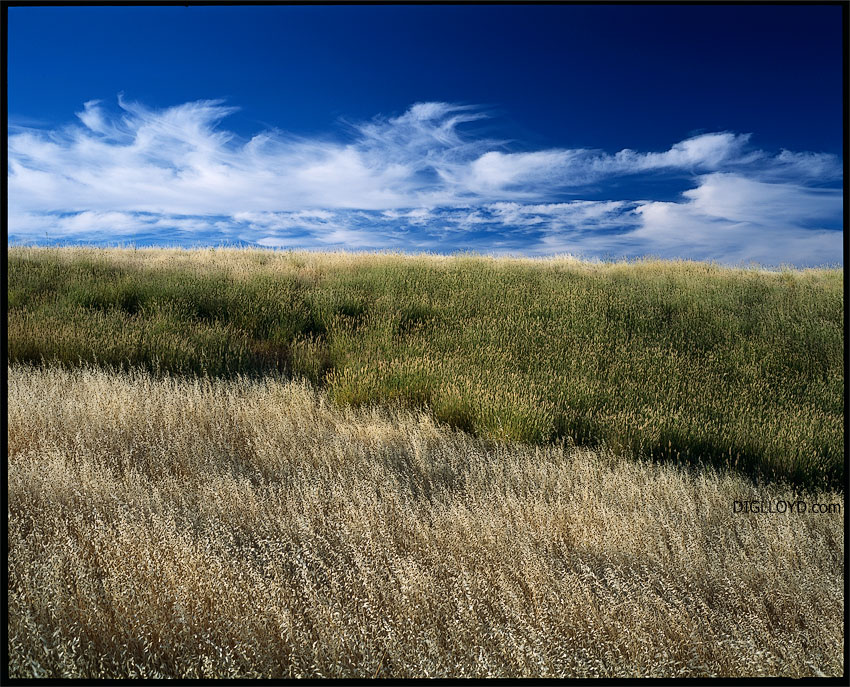
Mamiya 7 II, Fujichrome Velvia 50, 11470 X 9270 drum scan























